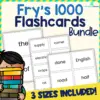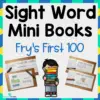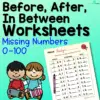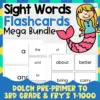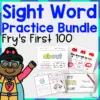The use of calendars in preschool is crucial to learning about time. Since time is not tangible, children need to understand its idea and make connections in their daily lives for it to make sense.
Here are ten meaningful calendar activities that will help children learn more about the topic.
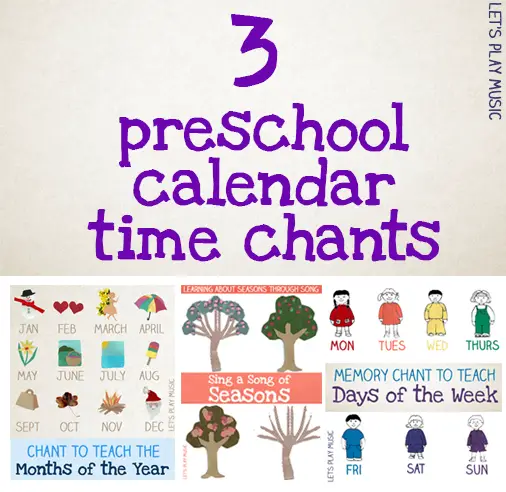
Songs and chants to teach the calendar is an ingenious way to help children remember time-related concepts such as days, months, and seasons. This cognitive skill is important for young children to learn.
As they sing and chant, they will recall the order of time, such as what goes before and after a specific month or day. Including this activity in the children’s routine will help them become aware of the current time.
The site suggests using songs to teach the days of the week, the months of the year, and the seasons.
For example, the Days of the Week song will help children remember the names of the days and their order. It will also help children understand the concept of yesterday, today, and tomorrow.
The phrase in the song “Off to church on Sunday” will help children connect specific activities for certain days. The phrase “Monday starts the week” signals a beginning and end to each week.
For this activity, you will need:
- A copy of the songs and chants
For more information on this activity, go to LetsPlayKidsMusic.com.
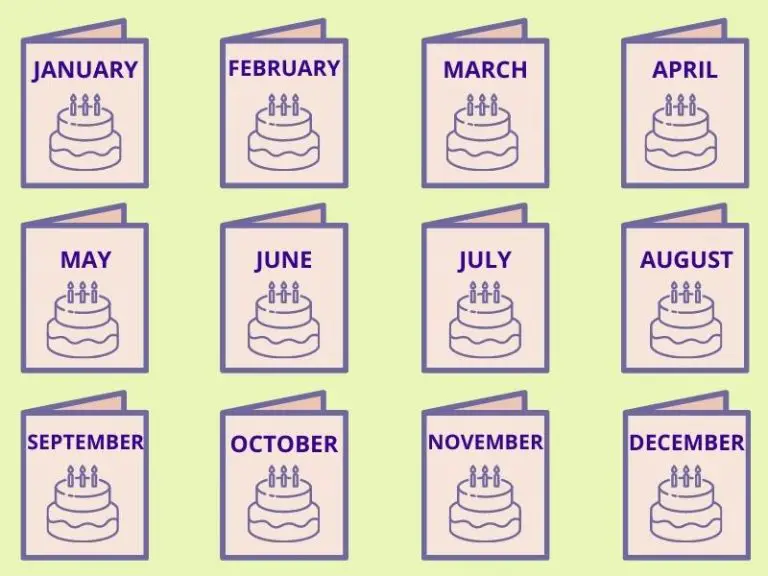
Celebrating birthdays provides children with opportunities to learn about the months of the year. Creating a birthday poster lets children visualize that time can be quantified in different ways, including days, weeks, and months.
Being able to name the months of the year will add words to their vocabulary and create awareness that birthdays are once a year and that months are arranged in a specific order.
To make the birthday cards, use pre-made cards or print one. Ensure that each card has a month printed on it. Prepare all twelve cards and take one from the pile. Next, show the card and let the children sing a birthday song.
The teacher will read the month’s name on the card and ask students whose birthday will fall on that month. Once children can identify the birthday celebrators, teach them the order of months.
Ask children what comes before and after that month. Use posters to guide children who may have difficulty recalling the months’ names.
For this activity, you will need:
- Birthday posters or cards
For more information on this activity, go to NumberDyslexia.com.
Related: Preschool Birthday Board Ideas
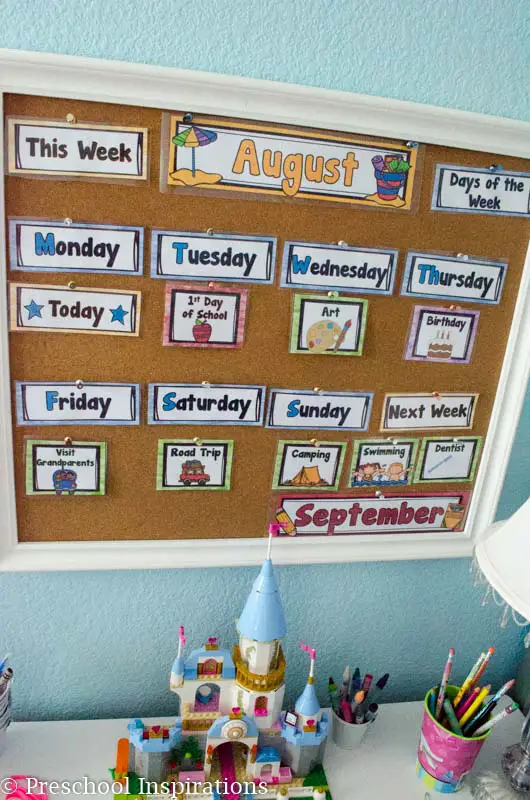
The visual schedule is a great tool to teach children time-related concepts, routine, and time-management skills. This can be perfectly incorporated in the preschool classroom by providing children with a list of activities they need.
This can simply be a list for children who can read and illustrated symbols for those who cannot. Placing them on the wall or a board helps children have a glimpse of what their week would be like.
The printable comes with big strips for the months to make as headers and smaller strips for the days of the week. This set contains dozens of visual cards about school children’s schedules.
It also includes picture cards for special events and holidays. It has yesterday, today, and tomorrow headers. Traditional calendar pieces like numbers are also added in this printable.
This visual schedule is downloadable from the site and can be easily printed. Laminate these cards and use pushpins or velcro dots to help organize the children’s schedule.
For this activity, you will need:
- Printed visual schedule
- Pushpins
For more information on this activity, go to PreschoolInspirations.com.
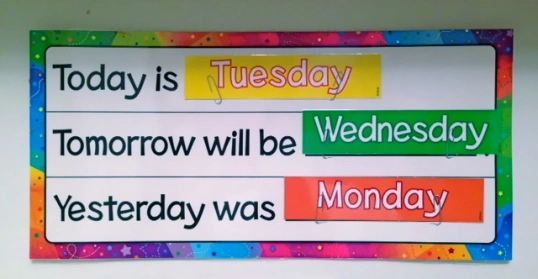
When children can identify the concepts of today, tomorrow, and yesterday, they learn other time-related concepts, which is past, present, and future.
Use ready-made posters or charts for this activity, or make one by printing and laminating the pieces for durability. Add velcro dots or adhesive dots to attach the pieces to the chart. Doing this step will make the pieces reusable for children.
This idea may be presented using the days of the week, but specific activities can also be an alternative. For example, today is art day, tomorrow is ball play day, and yesterday was music day.
Use words or pictures that correspond to the intended activity for this modification. The site suggests using the chart daily for repetition. This activity will help children understand the concepts.
This can be very helpful when there is an upcoming event that children cannot wait for. Knowing when the event will happen gives children a good sense of awareness and anticipation.
For this activity, you will need:
- Today, tomorrow, and yesterday chart
- Velcro dots
For more information on this activity, go to FrozenCokeFridays.wordpress.com.
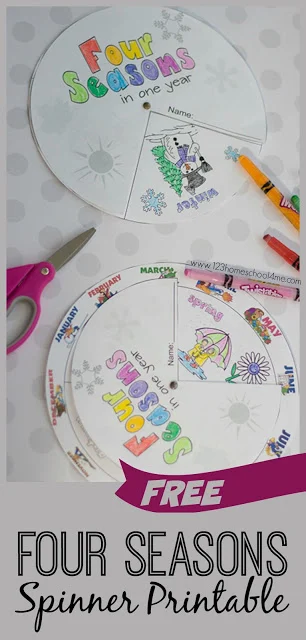
Seasons bring about changes in the environment. These changes occur at different times of the year. Knowing the current and the upcoming season will provide children with the knowledge to help them plan and organize their activities.
This knowledge will also be valuable in finding reasons for certain tasks or activities and help children think critically. For example, the children will not be asked to have water play outside during the winter season.
Download and print the free spinner from the site. Let children color the pages using markers or crayons. Next, cut out the pieces and punch a hole in the middle. Attach a brass fastener to secure the spinners.
The printable comes in two different sets and can be assembled in two ways. The first set includes the cover and the inner wheel with the names of the seasons and illustrations to show context.
The second set is almost the same, except the inner wheel includes the months of the year. This additional detail gives children an idea of the months when a particular season happens.
For this activity, you will need:
- Printed four seasons spinner
- Crayons or markers
- Hole puncher
- Brass fasterner
For more information on this activity, go to 123Homeschool4Me.com.
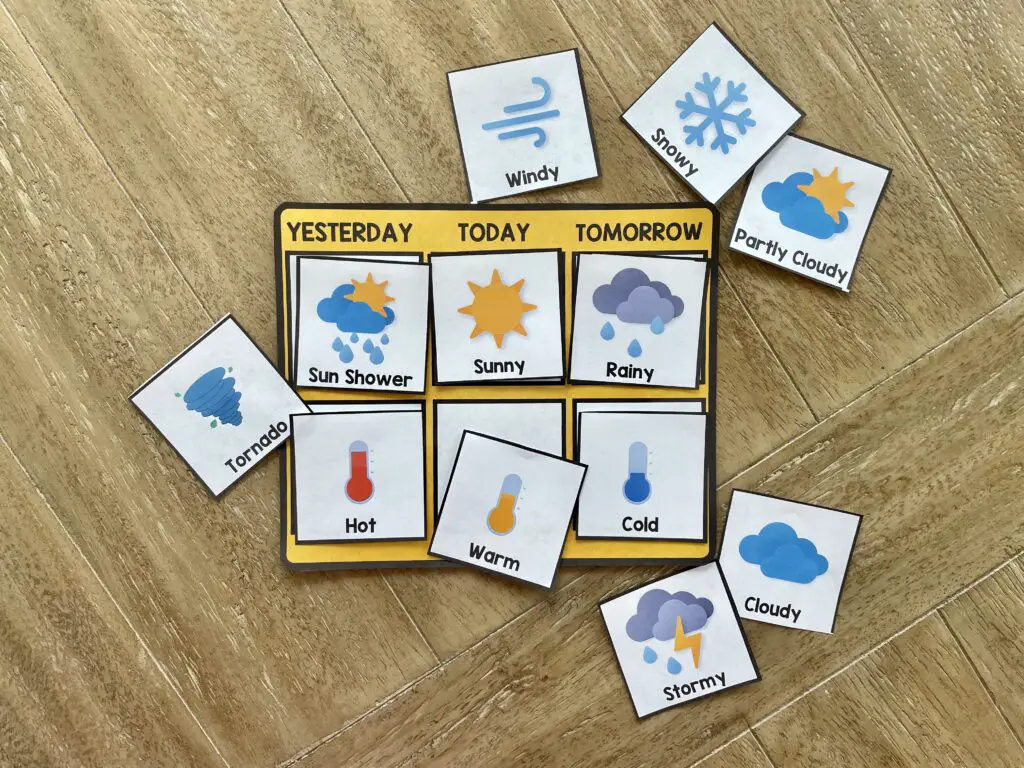
Weather charts do not just teach children the different types of weather that may happen. These can also be used to teach time-related concepts. In particular, these are the concepts of the past, present, and future.
Using visual cards to represent the weather and the temperature will help children understand the order of events. Thus, creating a sense of anticipation will help children plan for the future.
Download and print the free weather chart from the site. Cut out the pieces and laminate these, if possible, for durability. The site suggests printing the picture cards thrice in case the same weather occurs three times.
This weather chart is small and handy compared to the usual large charts used in the classroom. Therefore, each of the children can have one for them to practice on.
Children can learn how to observe the weather and record their findings using the chart. This task will help them remember and understand what yesterday, today, and tomorrow means through weather watch.
For this activity, you will need:
- Printed weather chart
For more information on this activity, go to TeachingLittles.com.
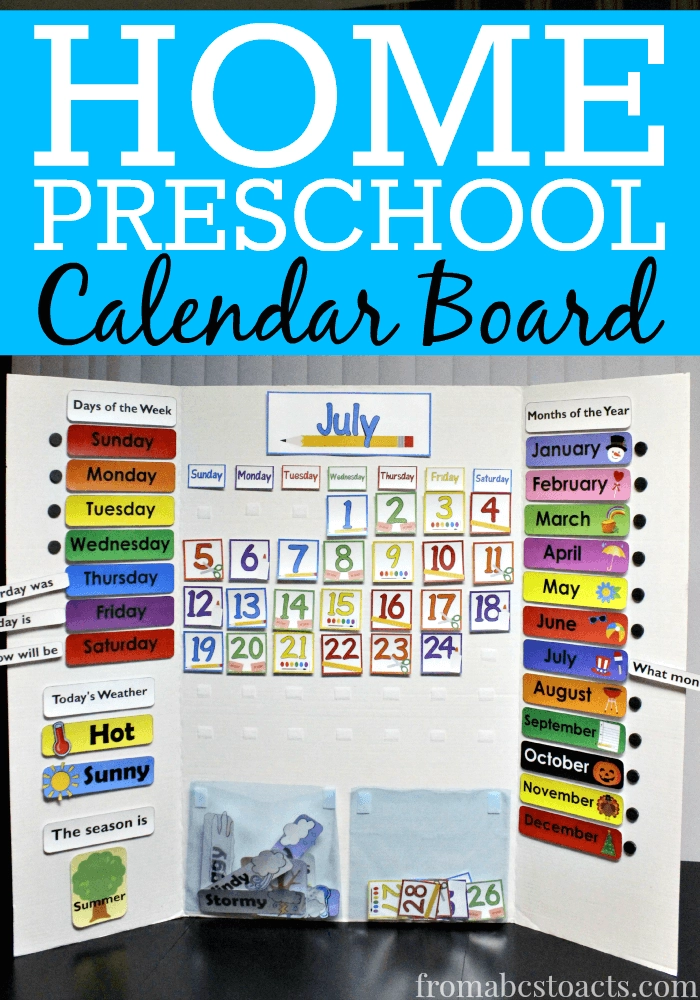
Preschool calendars are a great way to teach children to organize with time in mind. Children will see clearly how long a year is through the word strips with the months.
They will also understand that a week lasts seven days and a month has up to thirty-one days. This board teaches children time-related concepts and how to use a calendar.
This preschool board also includes the weather, temperature, and season. For durability, it is recommended that the pieces be laminated. Use velcro dots to attach the pieces on the board, but magnet dots are ideal for withstanding daily use.
Some pieces provide time-related clues such as “yesterday was,” “today is,” and “tomorrow will be” for the days of the week. Another strip asks the question, “What month is it?”
Each month of the year has an illustration representing a holiday or an event, such as the Christmas tree in December and a lollipop heart for February.
Download and print the free calendar pieces from the site. Cut these out and laminate them. Organize them by attaching velcro dots or magnet dots on the back of the pieces and onto the board. Refer to the pictures on the site for this step.
For this activity, you will need:
- Printed calendar
- Velcro dots or magnet dots
- Tri-fold presentation board
For more information on this activity, go to FromABCsToACTs.com.
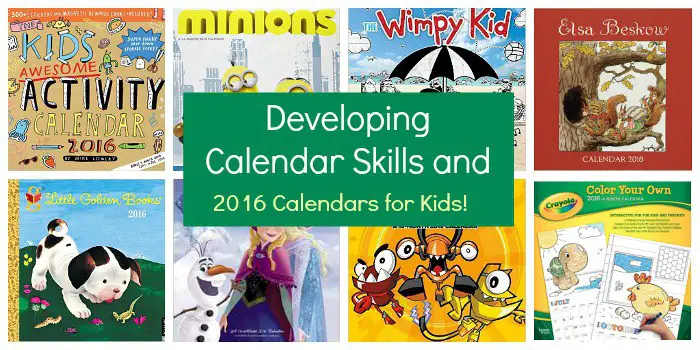
Children learn time-related concepts using a monthly calendar and time management. This activity helps children make plans and look forward to special events.
This is crucial for young children because it is an important skill they need growing up, even as adults. Knowing which day and events passed by will help children understand the concept of past, present, and future.
The site recommends crossing out each day that passed as a visual guide for children to indicate that the day has ended. Many different calendars are available in the market.
Some are inspired by popular animated characters, while some are interactive that require children to color the pages.
This magnetic calendar is an excellent tool for classroom and personal use. Children will find it easy and convenient to take off and attach the pieces on the chart.
It is small enough for children to work on but contains numerous details, such as the current date, the months of the year, the days of the week, the seasons, and the weather.
For this activity, you will need:
- Magnetic My First Calendar
For more information on this activity, go to BuggyAndBuddy.com.

This calendar is very personalized through the children’s involvement in making one. This activity follows the principles of Reggio Emilia, where children explore concepts and relate them with their experiences.
This calendar is a clear expression of their journey throughout the month and features different activities and events.
Children will become aware of the number of days in a month and the special days that happened through a simple way of documenting.
This simple activity will require children to draw and color, improving their fine motor skills while learning about time-related concepts.
Follow the calendar template to make this personalized calendar for kids. Write the month on a large strip of paper and place it on the top part of a cork board.
Take out several small unruled index cards and write a date on the upper left corner using a colored marker.
Next, have children cross out the dates they are not in school. These are the dates that fall on a Saturday and Sunday.
For the rest of the dates, let children draw a picture on the index card that is meaningful and related to their experiences on that day. Have children take turns drawing for each day until the month is complete.
For this activity, you will need:
- Index cards
- Cardstock
- Markers
- Crayons
- Stapler
- Cork board
For more information on this activity, go to FairyDustTeaching.com.
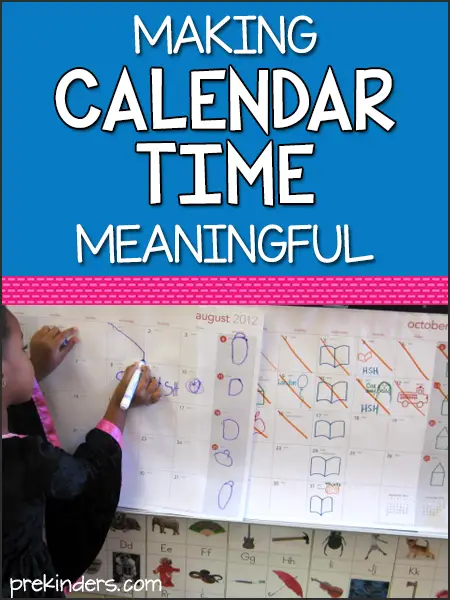
Using real calendars connects children to the reality of the passing of time and helps them understand other time-related concepts. Since time is an abstract concept, using real calendars allows children to visualize how days pass in a month.
Use a large block-type calendar with enough space for children to draw and write. The site recommends modeling adults’ actions when using the calendar, such as writing notes and crossing out days that have passed.
This way, monitoring the days can be habit-forming and may be a great way for children to learn time management. Make sure to point out that each block represents a day.
The site also suggests using phrases, such as “Yesterday was..” or “Tomorrow will be..” instead of having children memorize the days of the week by rote to make learning about calendars meaningful.
Model out special days and holidays through simple drawing or with the use of stickers. Draw simple images such as a house on days they are not in school or a strawberry to represent the field trip to a strawberry patch.
For this activity, you will need:
- A real block-type calendar
- Markers
For more information on this activity, go to PreKinders.com.
Conclusion
Calendar activities teach time-related concepts such as days of the week, months of the year, the concepts of present, past, and future, seasons, and holidays. Children will not only increase their vocabulary but also learn about chronology.
Help children understand time, while not something they can touch and see, is something that happens and you can look forward to.
Let children explore these different activities to help them become aware of time.
Thank you for reading!


